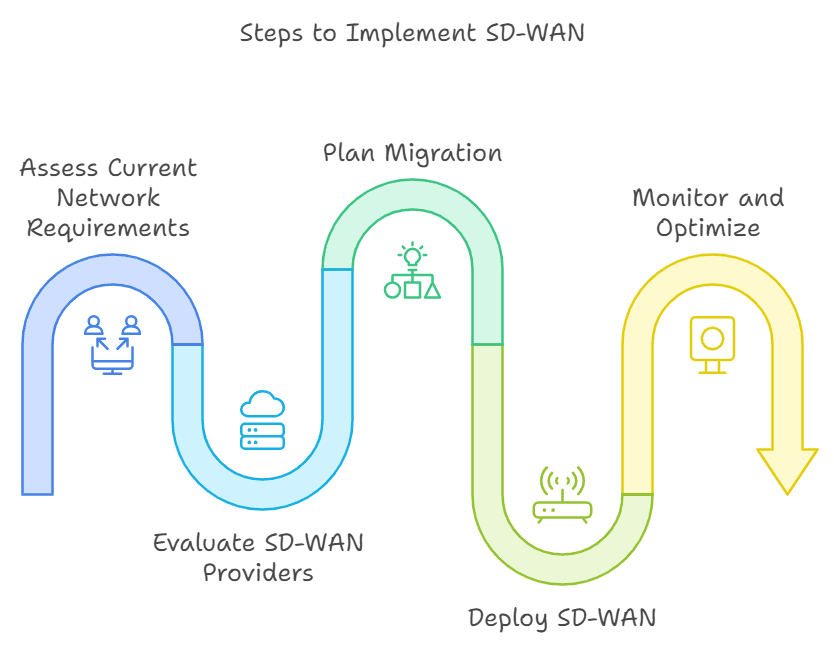SD-WAN vs Traditional WAN: Which is Right for Your Business?
In today’s fast-paced digital environment, businesses are shifting from traditional networking methods to advanced solutions that offer greater flexibility and efficiency. One of the most significant comparisons is SD-WAN vs Traditional WAN. As businesses grow and their needs evolve, the debate between these two network architectures becomes crucial. This blog will explore the differences between SD-WAN and Traditional WAN, highlighting which option might be right for your business.
ما هو WAN - SD؟
Software-Defined Wide Area Network (SD-WAN) is a virtual WAN architecture that allows enterprises to leverage any combination of transport services—including MPLS, LTE, and broadband internet—to securely connect users to applications. SD-WAN uses a centralized control function to direct traffic across the WAN, improving application performance and providing a superior user experience.
Key Features of SD-WAN:
- Centralized control
- Traffic management and routing
- Application prioritization
- Cloud compatibility
- Cost efficiency
What is Traditional WAN?
Traditional WAN (Wide Area Network) connects multiple locations through a private network, often using technologies like MPLS or leased lines. It typically relies on routers to forward traffic based on IP addresses and manual configuration. Traditional WANs are designed for a time when most business applications were hosted on-site and used internal data centers.
Key Features of Traditional WAN:
- Uses MPLS or private circuits
- Manual configuration
- Best suited for on-premise applications
- Expensive, with higher operational costs
SD-WAN vs Traditional WAN: A Comparison
Below is a comparison table highlighting the key differences between SD-WAN and Traditional WAN:
| Feature | SD-WAN | Traditional WAN |
| Cost Efficiency | Lower costs due to broadband use | Higher costs with MPLS |
| Traffic Management | Dynamic, application-aware | Static routing |
| Cloud Compatibility | Highly compatible | Limited cloud integration |
| Deployment | Quick and flexible | Slow, manual deployment |
| Network Visibility | Centralized visibility | Limited visibility |
| Security | Integrated security | Requires additional security layers |
| Scalability | Easily scalable | Complex and costly scaling |
1. Cost Efficiency
- SD-WAN: One of the key benefits of SD-WAN is its cost efficiency. By allowing businesses to use a mix of low-cost broadband connections and high-performance MPLS, SD-WAN offers significant savings.
- Traditional WAN: Traditional WANs rely on costly leased lines or MPLS, making them a more expensive option in terms of both installation and operational costs.
2. Traffic Management
- SD-WAN: With SD-WAN, traffic is managed dynamically, ensuring that important applications are prioritized and less-critical traffic is deprioritized. It can automatically route traffic through the best available path, enhancing overall performance.
- Traditional WAN: In contrast, Traditional WAN typically uses static routing, which lacks the flexibility to adapt to real-time network conditions, often leading to inefficient traffic flow.
3. Cloud Compatibility
- SD-WAN: SD-WAN is designed with the cloud in mind. It provides seamless connectivity to cloud applications and services, offering a superior experience for users who rely on SaaS, IaaS, or other cloud-based solutions.
- Traditional WAN: Traditional WAN struggles with cloud integration since it is more suited for on-premise applications and often routes traffic back to the data center, causing latency issues.
4. Deployment Time
- SD-WAN: SD-WAN allows for fast deployment, with centralized management making it easy to roll out across multiple locations.
- Traditional WAN: Traditional WAN requires manual configuration and typically involves lengthy installation periods, especially when deploying new hardware at multiple sites.
5. Network Visibility
- SD-WAN: SD-WAN offers centralized visibility and control, allowing network administrators to monitor and manage the entire network from a single dashboard.
- Traditional WAN: Network visibility in Traditional WAN is limited, often requiring separate tools and manual efforts to gain insights into performance issues.
6. Security
- SD-WAN: Security is built into SD-WAN, with features like end-to-end encryption and integrated firewalls. SD-WAN can segment traffic and enforce security policies across the network.
- Traditional WAN: Security must be layered on top of Traditional WAN, making it a more complex and costly endeavor.
7. Scalability
- SD-WAN: SD-WAN is highly scalable, allowing businesses to easily add new sites or branches without requiring a complete overhaul of the network infrastructure.
- Traditional WAN: Scaling a Traditional WAN is a complex process that can involve significant time and cost, as it often requires new circuits and equipment.
When to Choose SD-WAN
SD-WAN is an ideal solution if your business meets the following criteria:
- Cloud-Heavy Workloads: If your business relies on cloud-based applications like Microsoft 365, Salesforce, or Google Workspace, SD-WAN will provide better connectivity and performance.
- Multiple Locations: Businesses with multiple offices or branches benefit from the centralized control and ease of deployment that SD-WAN offers.
- Cost-Sensitive Operations: SD-WAN helps reduce costs by utilizing cheaper broadband connections alongside traditional MPLS circuits, offering a cost-effective solution.
- Need for Flexibility: If you need a network that adapts quickly to new requirements or locations, SD-WAN’s flexibility and fast deployment capabilities are unmatched.
- Focus on Security: SD-WAN integrates security features like encryption and firewalling, providing comprehensive protection across the network.
Steps to Implement SD-WAN:

- Assess Current Network Requirements: Understand the current state of your network and what improvements you need.
- Evaluate SD-WAN Providers: Compare different SD-WAN providers to find the one that fits your budget and needs.
- Plan Migration: Develop a migration plan that minimizes disruption to your business operations.
- Deploy SD-WAN: Start deployment in phases, ensuring proper integration with existing infrastructure.
- Monitor and Optimize: Continuously monitor SD-WAN performance and make adjustments as necessary.
When to Choose Traditional WAN
Traditional WAN may still be a good choice for businesses that meet the following conditions:
- Single Location: If your business operates from a single location with limited need for external connectivity, Traditional WAN could suffice.
- Mission-Critical, On-Premise Applications: If your applications are primarily hosted on-premise and have stringent reliability requirements, Traditional WAN can offer dedicated bandwidth through MPLS or leased lines.
- Legacy Infrastructure: If your business is already heavily invested in Traditional WAN and you are satisfied with its performance, the cost of switching to SD-WAN may outweigh the benefits.
Steps to Manage Traditional WAN:
- Review Current Infrastructure: Analyze the performance and cost-efficiency of your existing WAN.
- Evaluate Future Requirements: Determine if your current WAN will meet the needs of future growth or cloud migration.
- Optimize Traffic: Fine-tune routing to improve the performance of critical applications.
- Assess Security: Ensure adequate security measures are in place to protect your network.
Conclusion: SD-WAN vs Traditional WAN – Which is Right for You?
In the battle of SD-WAN vs Traditional WAN, the choice depends largely on your business’s specific needs. For businesses heavily reliant on cloud applications, with multiple locations and a focus on flexibility, SD-WAN is likely the superior option. It offers better performance, scalability, and cost-efficiency.
However, for businesses that operate from a single location with a reliance on on-premise applications, a Traditional WAN might still make sense, particularly if the business already has a well-established infrastructure.
By carefully evaluating the differences and considering your business’s goals, you can make an informed decision that aligns with your network requirements.



